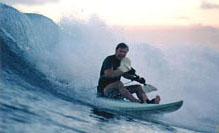The fundamental rule of the surf zone, regardless of whether you're on a surf board or kayak is this: Your proximity to others must be directly proportional to your ability to steer your craft. A touring kayak, for instance, has very little steering ability once surfing, and when broached it is essentially a steam roller to anything in its path. If there is much danger of broaching or pearling (burying your bow in the water), you must stay well away from everyone else in the water. Conversely, an expert surfer in a High Performance Class boat can make extremely tight radius turns, and can therefore safely maintain close quarters to other surfers.
The other thing that is very important to understand is that surfing, as it has been practiced by board surfers for decades, is based upon moving sideways on the wave, not barreling in straight towards the beach. To safely coexist with other wave riders, you must understand what they are trying to do on the wave and what it means to have the Right-of-way.

A high quality surfing wave looks something like a zipper. At one point you have an unbroken "green wave". When the combination of wave speed, volume, and bottom contours reaches a critical point, the wave steepens to where it begins to break, or turn into a "foam pile". The surfer strives to practice his/her art on the green face right next to the broken portion of the wave. This is called the "pocket" and is where the wave is steepest and where the fastest and most dynamic moves are possible to the surfer. The pocket is constantly moving both towards the shore and parallel to it.
Many surf boards and some kayaks cannot catch a wave at all except in the pocket. These craft are designed for extreme maneuverability in the pocket at the expense of flat-water speed. It is not uncommon for someone with a board or boat like this to only catch a handful of waves during a session, because there are only so many times when they are positioned just right to drop into the pocket, with nobody else already there.
Conversely, many kayaks have so much hull speed (especially compared to a surf board), that they can catch a wave well away from the pocket. The surfer in the pocket has the right of way on that wave. So if you are happily cruising along on an unbroken portion of the wave, and you see someone in the pocket coming towards you, you are expected to abandon that wave. If you lack the skills to move out of the way, you shouldn't be there in the first place.
The most important thing that kayakers need to realize is this: just because you can catch a wave doesn't mean that you should. If the speed of your boat allows you to catch every wave you want to, you could theoretically jump on a wave and claim the pocket before the board surfers ever have the opportunity. This kind of selfish behaviour can only worsen surfer/kayaker relations. Some days there may be only a very small number of quality waves, and if you follow the etiquette, that may mean even fewer for you, and it can be frustrating. But sometimes you have to wait in line, even when doing your favorite thing.

